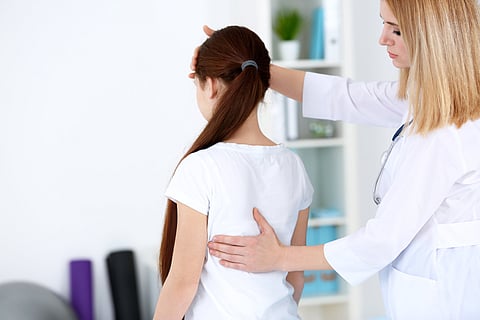FRIDAY, June 23, 2023 (HealthDay News) -- The future for a child diagnosed with scoliosis, an abnormal curvature of the spine that typically occurs just before puberty, can feel uncertain.
As a parent, you want answers to your questions about scoliosis and how it can affect your child's development. Here’s what you need to know.
What is scoliosis?
Scoliosis is an abnormal sideways curvature of the spine. In some cases, the spine curves either to the left or the right in a “C” shape. In others, the spine curves both ways in an “S” formation, according to Boston Children’s Hospital.
What causes scoliosis?
The National Institute of Arthritis and Musculoskeletal and Skin Diseases (NIAMS) explains idiopathic scoliosis is the most common type and the cause is unknown; however, a combination of genes, hormones and changes in cell structure could be the cause.
Other causes include:
- Congenital factors occurring during fetal development
- Genetic disease
- Traumatic injury
- Neuromuscular diseases like cerebral palsy
- Tumors
Types of scoliosis
“There are three primary types,” said Dr. Stephen George, a pediatric orthopedic surgeon at Nicklaus Children's Hospital in Miami.
George explains in an online video the three types are: congenital; neuromuscular; and the most common, idiopathic scoliosis.
Congenital scoliosis is caused by malformed vertebrae during fetal development.
Neuromuscular scoliosis is due to weak muscles that are unable to support the spine. This is the result of muscle impairment from diseases like cerebral palsy. Severe scoliosis can occur in patients who are unable to walk.
Idiopathic scoliosis (AIS) has no definitive cause.
Is scoliosis genetic?
Researchers continue to study whether there’s a genetic component to AIS. According to the Scoliosis Research Society, “Approximately 30% of AIS patients have some family history of scoliosis, which would indicate a genetic connection.”
Scoliosis symptoms
Children don’t usually complain about back pain with scoliosis. Instead, parents should look for the following signs, especially if there is a family history of scoliosis, says Boston Children’s Hospital:
- Uneven shoulder heights
- Head not centered over the rest of the body
- Uneven shoulder blade heights or positions
- One shoulder blade more prominent than the other
- One arm longer than the other when standing up straight
- Uneven hip heights or positions
- Lopsided appearance of the back when bending forward
Scoliosis treatment
The degree of the curve determines the severity of a child’s scoliosis: mild, moderate or severe. Boston Children’s Hospital explains the level of severity is one factor in determining treatment, along with the type of scoliosis and the child’s developmental stage.
Treatment options include:
Observation and monitoring: For patients with mild scoliosis, especially if they’re still growing. Monitoring during growth spurts is important and includes regular doctor visits and imaging.
Bracing and casting: Your doctor may recommend a scoliosis brace or a cast for moderate scoliosis in children still growing. This can slow or stop the curve from progressing. The brace is customized and worn for a prescribed length of time each day.
Physical therapy: One physical therapy regimen is the Schroth method, which includes breathing exercises, physical movement and other forms of physical therapy. Maintaining activity and mobility are important for scoliosis self-care.
Surgery: Scoliosis surgery is considered for children with severe scoliosis who have passed their growth spurt and haven’t responded to other forms of treatment. Spinal fusion is the most common surgery.
Scoliosis exercises
Children’s Hospital of Orange County explains the goal of scoliosis exercises is to “promote symmetry within the spine to regain trunk alignment and reduce back pain.”
Consult with your child’s doctor before beginning any new activities or exercise.
Pelvic tilt: (Complete 2 sets per day)
- Start by lying on your back with knees bent and feet flat on the floor.
- Flatten the back by tightening the stomach and buttock muscles.
- Hold for 5 seconds while breathing normally.
- Complete 10 times for one set.
Cat-camel: (Complete 2 sets per day)
- Start on the floor on your hands and knees and back flat.
- Tighten abdominal muscles and keep your head and neck straight (looking forward).
- Next, take a deep breath, round the back and relax the neck.
- While breathing out, lower the back to the original flat position and tighten your abdominal muscles.
- Complete 10 times for one set.
Single-leg balance: (Complete 1 set per day)
- While standing on the floor, eyes open, bring one knee up and balance on the opposite foot.
- Hold for 10 to 20 seconds.
- Switch legs and repeat.
- For support, start by holding onto a chair.
- Over time, increase the challenge and let go of the chair, cross your arms across the chest or close your eyes.
Living with scoliosis
The National Institutes of Health suggests patients diagnosed with scoliosis stay active, to improve muscle and bone strength. Joining a scoliosis support group can also help them cope with the diagnosis and treatment.
“The diagnosis of scoliosis does not imply that your child will ever have any limitations. Whether the deformity requires observation, bracing or even surgery, children usually return to all activities without limitations,” George explains in this online video.



